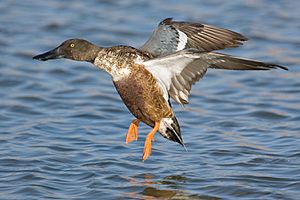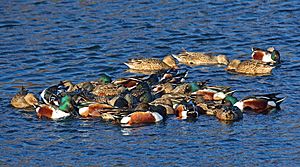Northern Shoveler facts for kids
Quick facts for kids Northern shoveler |
|
|---|---|
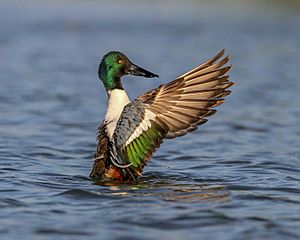 |
|
| Male | |
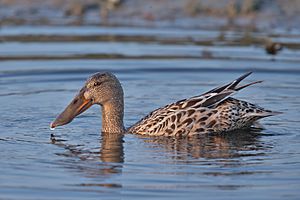 |
|
| Female | |
| Conservation status | |
| Scientific classification | |
| Genus: |
Spatula
|
| Species: |
clypeata
|
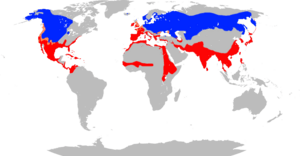 |
|
| Range distribution of Northern shoveler blue : breeding area (summer) red : nonbreeding area (winter) |
|
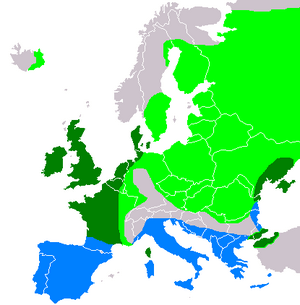 |
|
| European distribution. Summer only range All-year range Winter only range | |
| Synonyms | |
|
Anas clypeata Linnaeus, 1758 |
|
The Northern Shoveler is a common and widespread type of duck. It is easy to recognize because of its large, spoon-shaped bill. These ducks breed in northern parts of Europe and Asia, and across most of North America. Sometimes, they are seen in Australia, but that is very rare. In North America, they breed along the southern edge of Hudson Bay and west of it. They also breed as far south as the Great Lakes, stretching west to Colorado, Nevada, and Oregon.
Contents
What Northern Shovelers Look Like
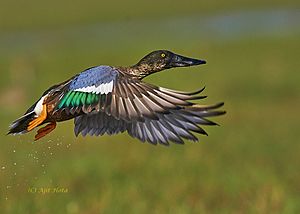
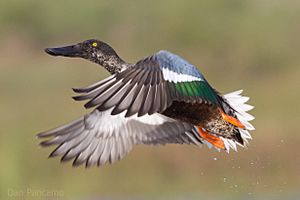
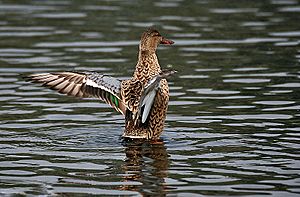
You can easily spot this duck in the northern parts of the world because of its big, spoon-shaped bill. The male duck, called a drake, has a shiny dark green head when it's breeding season. Its chest is white, and its belly and sides are a reddish-brown color.
When the male flies, you can see light blue feathers on its front wing. These are separated from the green speculum (a patch of bright feathers) by a white stripe. In early fall, the male will have a white crescent shape on each side of its face. When it's not breeding season, the male looks more like the female.
The female duck is a dull, mottled brown color. She looks a lot like a female mallard duck. However, you can easily tell her apart by her long, wide bill. This bill is gray with orange edges on the lower part. The female's front wing feathers are gray.
Northern Shovelers are about 48 centimeters (19 inches) long. Their wings can spread out to about 76 centimeters (30 inches). They usually weigh around 600 grams (1.3 pounds).
Behavior and Life Cycle
Northern Shovelers find their food by "dabbling." This means they dip their heads into the water to eat plants. They often swing their bill from side to side to strain food from the water. They use their special bill to catch small water animals like tiny crustaceans and plankton. Their wide, flat bill has comb-like structures called lamellae on the edges. These act like a sieve, filtering food from the water's surface.
This special bill helps them find food that other ducks might not eat. This means they don't have to compete for food as much. Because of this, they prefer to live in muddy marshes that are full of small water creatures.
The shoveler likes to build its nest in grassy areas, away from open water. Their nest is a shallow dip in the ground. It is lined with plant material and soft feathers. Female shovelers usually lay about nine eggs.
Male shovelers are very protective during breeding season. They will defend their territory and their partners from other males. Males also perform special dances and flights to attract a female. It's common to see many males chasing one female in the air. Even though they look a bit plump, shovelers are excellent flyers!
These ducks are usually quite quiet. The male makes a clunking sound. The female makes a "quack" sound, similar to a Mallard.
Where Northern Shovelers Live
This bird lives in open wetlands, like wet grasslands or marshes. These places often have some plants growing out of the water. Northern Shovelers breed in large areas across Eurasia, western North America, and the Great Lakes region of the United States.
In winter, these birds fly south to warmer places. They spend winter in southern Europe, Africa, the Indian Subcontinent, northern South America, the Malay Archipelago, Japan, and other areas. Those that winter in the Indian Subcontinent fly a very long way over the Himalayas. They often stop in wetlands just south of the Himalayas before continuing further south.
In North America, they spend winter south of a line from Washington to Idaho. They also winter from New Mexico east to Kentucky, and along the Eastern Seaboard as far north as Massachusetts.
In the British Isles, many Northern Shovelers are seen in winter. They are most common in southern and eastern England, especially around the Ouse Washes, the Humber, and the North Kent Marshes. Fewer are seen in Scotland and western England. In winter, the birds that bred there fly south. Then, new birds arrive from colder parts of Europe. They breed across most of Ireland, but it's hard to count how many there are.
Northern Shovelers are very migratory birds. This means they travel long distances for winter. They have even been reported as far south as Australia, New Zealand, and South Africa, though this is rare.
Gallery
Images for kids
-
Male northern shoveler in Butte County, California.
See also
 In Spanish: Cuchara común para niños
In Spanish: Cuchara común para niños



